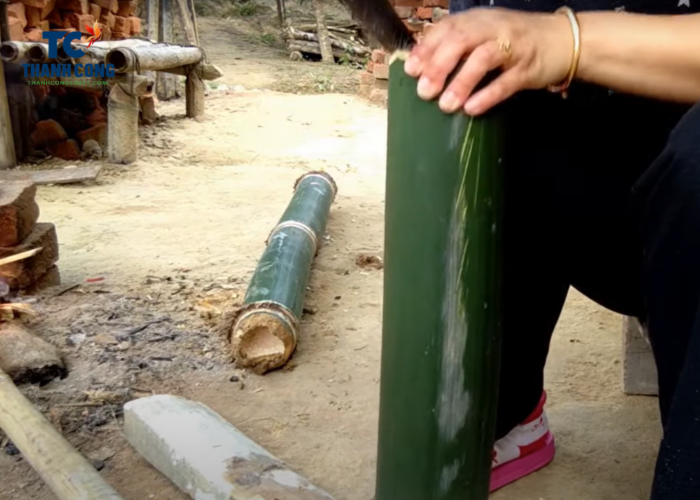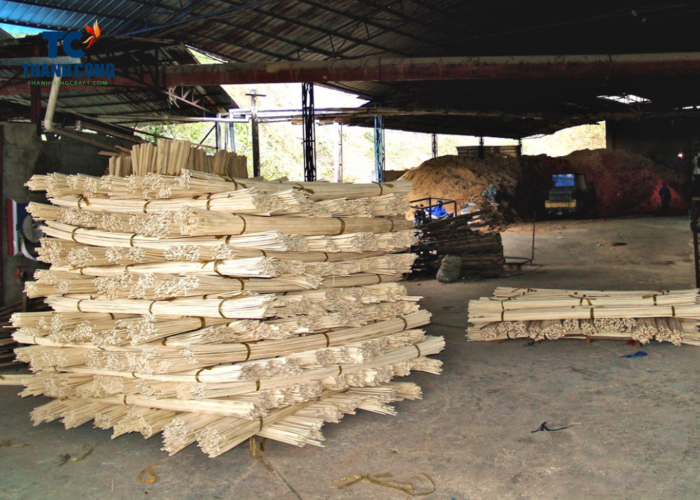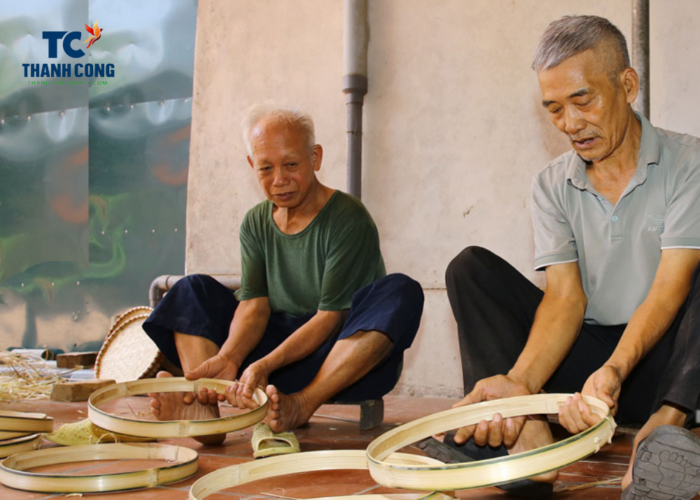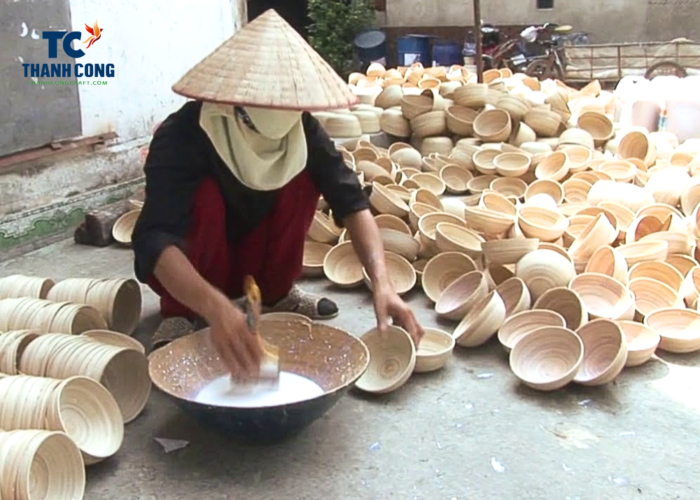Bamboo bowls hold a special place in Vietnamese culture, representing more than just practical vessels for food. They embody qualities of resilience, simplicity, and a deep connection to nature. Have you ever wondered how to make a bamboo bowl?
In this article, we’ll walk you through the steps to fashion a beautiful and durable bamboo bowl using readily available materials.
1. How to make a bamboo bowl?
Creating a bamboo bowl is a rewarding and eco-friendly project that allows you to craft a functional and aesthetically pleasing item. Here’s a step-by-step guide on how to make your own bamboo bowl:
Materials Needed:
- Bamboo Stalks: Select mature and straight bamboo stalks.
- Pruning Shears or Saw: For cutting bamboo.
- Knife: For shaping and carving.
- Sandpaper: To smooth out rough edges.
- Wood Finish (Optional): To protect and finish the bowl.
Step 1. Choose and cut bamboo
You should choose bamboo with a light color, no cracks or termites. You cut the bamboo into short pieces, about 20-30 cm, depending on the size of the bowl you want to make. You also need to cut off the leaves and small branches of the bamboo.

Step 2. Split and open bamboo
Use a paper cutter or a bamboo scraper to split the bamboo strips from the bamboo piece. You should split 4-6 bamboo strips for each piece, depending on the thickness of the bamboo. Then, you use a saw or scissors to cut the bamboo to expand the bamboo strips into wider pieces. You should leave the pieces with a thickness of 2-4 mm and a width of 5-10 cm.

Step 3. Bend and shape the bowl
You use a feather duster or a cloth to wipe off dust and dirt on the surface of the pieces. Then, you use a pot of boiling water or a microwave to heat and soften the pieces. You should leave the pieces in boiling water for about 10 minutes or in the microwave for about 2 minutes.
When the pieces are soft, you quickly bend and join them together according to the shape of the bowl. You can use an existing bowl as a mold to bend along.
Drill or rivet to fix the pieces together. It’s recommend to drill or rivet 2-4 holes for each piece and leave a distance of 2-3 cm between the holes.

Step 4. Glue and preserve the bowl
Use glue to glue the pieces together and cover the holes drilled or riveted. You should let the bowl dry completely after gluing, about 24 hours. Then, you use a preservative to coat the surface of the bowl. You should let the bowl dry again after coating, about 12 hours. You can repeat this step several times to increase durability and beauty for the bowl.

2. FAQs
2.1 How do you oil a bamboo bowl?
To oil a bamboo bowl, you need to prepare a kind of odorless vegetable oil, such as grape seed oil or olive oil. Then, you need to wash the bamboo bowl with warm water and mild soap, and let it dry completely.
When the bamboo bowl is dry, you can apply a thin layer of oil on its surface with a clean cloth or a brush. You should let the bamboo bowls absorb the oil for about 15 minutes, then wipe off the excess oil with a dry cloth.
You should repeat this process at least once a month to keep the bamboo bowl beautiful and prevent cracking.
2.2 Can bamboo bowls get wet?
The water resistance of bamboo bowls may vary depending on factors like the material, manufacturing process, and storage method. While some bamboo bowls can tolerate exposure to water, it’s crucial to avoid prolonged soaking and dishwasher use.
If a bamboo bowl becomes wet, prompt drying is necessary to prevent mold or warping. Additionally, refrain from subjecting the bamboo bowl to high temperatures or direct sunlight, as this could potentially damage its surface or alter its color. Bamboo bowls, being environmentally friendly and recyclable, require thoughtful usage and storage practices to maximize their lifespan
2.3 Are bamboo bowls healthy?
Bamboo bowls are a healthy and safe choice for serving food due to several factors. As a natural and non-toxic material, bamboo ensures that no harmful chemicals leach into the food, a concern often associated with certain plastics. Unlike some other materials, bamboo bowls typically do not require additional coatings or treatments, eliminating the risk of introducing potentially harmful additives.
With low allergenic potential, bamboo is a suitable option for those with material sensitivities. Furthermore, the eco-friendly nature of bamboo, being a rapidly renewable resource, aligns with sustainable and responsible consumption. In addition to being lightweight and easy to handle, bamboo bowls boost durability, making them resistant to breakage and contributing to both safety and longevity.
2.4 Can you eat soup out of a bamboo bowl?
Yes, you can eat soup out of a bamboo bowl. Bamboo bowls are suitable for serving a variety of foods, including soups and liquids. They are lightweight, durable, and have a natural resistance to absorbing flavors or odors.
However, it’s important to note that not all bamboo bowls are designed for hot liquids, so it’s recommended to check the specific guidelines provided by the manufacturer.
Some bamboo bowls may have protective coatings or finishes, and exposing them to very hot liquids or prolonged heat may affect the integrity of the bowl. Always follow the care instructions for your specific bamboo bowl to ensure its longevity and safe use.
2.5 Can you put hot food in bamboo bowls?
Bamboo bowls are generally suitable for serving hot or warm food, and they are known for their heat resistance. It’s important to check the care instructions provided by the manufacturer, as some bamboo bowls may have protective coatings or finishes that could be affected by excessive heat.
While bamboo is heat-resistant, it’s advisable not to leave extremely hot food or liquids in the bowl for extended periods, as this could impact the integrity of the bamboo over time. Allowing hot foods to cool slightly before transferring them to the bamboo bowl is a good practice. Regularly inspecting the bowl for signs of damage or wear, especially if regularly used for hot foods, ensures its longevity and safe use
Using simple tools and natural materials, you can create beautiful and durable bamboo bowls. In this article, we have guided you through the basic steps to make a bamboo bowl from choosing the bamboo, cutting, shaping, polishing and decorating. We hope you will try to do it and enjoy the creative process.
If you have any further questions, don’t hesitate to send thanhcongcraft an email us at info@thanhcongcraft.com or message us at WhatsApp: +84967485411. Hope to serve you soon! Best regard!












